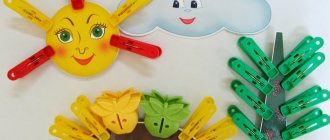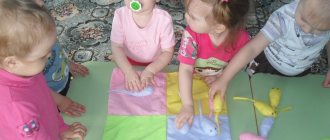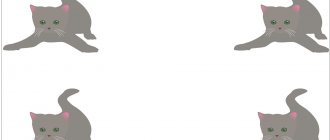What are fine motor skills
Fine motor skills are the consistency and precision of movements required to perform various actions with small objects using the hands and fingers and toes.
Fine motor skills are evident in children from an early age, when they are just learning to hold a toy. First, the development of the hand and finger movements occurs, then the formation of speech is formed. The formation of speech through the development of fine motor skills occurs due to the influence of nerve endings on the parts of the brain responsible for motor skills and speech, which are located next to each other.
In addition to the main function - speech development - fine motor skills influence the development of mental processes: thinking, memory, imagination, and the ability to navigate in space.
Fine motor skills - what is it and how does it affect the child’s condition?
Imagine picking up a tennis ball and a grain of rice. Agree, it’s much easier and faster to grab the ball: close your fingers and you’re done. Whether it’s raising a small grain, you need to get used to it, pick up and hold this crumb.
It's all about physiology . The human hands are equipped with a large number of muscles, both large and small. We train large muscles every time we make any movements with our hands and fingers. But small muscles “rest” and do not develop until we begin to make small and precise manipulations.
Give a baby a coin - he will clutch it in his palm, no matter how interesting it is to him. But a four or five year old child will be able to pick it up with his fingers and carefully examine it. This simple difference is the effect of developed fine motor skills.
So, fine motor skills are the degree of development of the small muscles of the hands, which are used for precise and small movements. Then why develop it?
The excitement around fine motor skills began quite a long time ago, when M. Montessori, V.A. Sukhomlinsky, A.R. Luria discovered an interesting relationship: children with delayed speech development could not work with small objects, while children with a normal level of development actively used them.
This discovery became an impetus for other research in the fields of psychology, pedagogy and physiology. As a result, it was discovered that the accuracy of performing small manipulations is associated with the work of the speech parts of the brain, consciousness, thinking, spatial orientation, memory and vision.
Accordingly, by working on a child’s fine motor skills, you not only develop small hand muscles, but also train his brain, use the visual, skeletal, muscular, and nervous systems. Not a bad bonus for a caring parent, right?
Features of the development of fine motor skills
The ability to master fine motor skills in children does not develop on its own, that is, it does not have a hereditary factor. Adults play a great role in this matter; by their example, they involve the child in various activities and develop him systematically and purposefully. This hypothesis was first put forward by the Russian scientist Ivan Mikhailovich Sechenov. Subsequently, other scientists, doctors, teachers and specialists in various fields began to focus on this opinion as the key one.
Why is so much attention paid to the development of fine motor skills? For children, it means the development of basic skills and abilities.
- The child’s speech is formed, which contributes to a comfortable stay in the children’s group.
- The skills of various movements are developed. The child can play with toys independently without distracting an adult.
- Self-service skills are strengthened. The child gains the ability to independently hold a spoon, tie shoelaces, fasten buttons and other elements on clothes.
- Social connections are established with peers and adults, thanks to the ability to clearly express one’s thoughts and maintain dialogue.
- Readiness for schooling is formed through the combination of all the above reasons.
Games and exercises aimed at developing fine motor skills
The main activity of preschool children is play. We have selected a variety of games and exercises for you, among which you will definitely find something that suits you and your child.
- Folding toys. We place a transparent container in front of the child and place small toys separately. We suggest putting toys into the container with your right hand. Then we pour them back and ask you to repeat the same actions with your left hand.
- Games with cereals. In one container we mix two types of cereals, for example, rice and buckwheat. It is necessary for the child to put these cereals into different containers. You can complicate the game by adding other small objects to the mixture of cereals, for example, beads, buttons, pebbles.
- Exercise for tearing a sheet of paper. First, draw random lines on a sheet of paper. We invite the child to tear the paper with his hands exactly along the drawn lines. You can complicate the task by depicting geometric shapes.
- Page turning exercise. As your child gets older, instead of tearing a sheet of paper, you can suggest flipping through the pages of a favorite book. This exercise also promotes the child's early interest in reading literature.
- Smoothing out a crumpled sheet of paper. We place a crumpled sheet of paper in front of the child and offer to smooth it out so that not a single bent corner remains. You can complicate the exercise by suggesting that you do it with one hand, while holding the sheet with your thumb.
- Games with cubes. We give the task to assemble various figures from cubes: a tower, a house, a car, etc. Pyramid rings are also suitable for these games. The tasks become more complicated as the child masters the construction of simple figures.
- Games with lacing. Available in various options. It can also be an unnecessary shoe that you can let your child lace and unlace. It could also be a card with holes for laces. In any case, the actions with these objects are the same and pursue the same goal - to teach the child to cope with shoelaces on his own, since this skill will be useful to him in the future.
- Exercises with counting sticks. Please place geometric shapes on the table. First, the child completes tasks according to the model, and then independently according to verbal instructions. An additional advantage of this exercise is the formation of elementary mathematical concepts.
- Games with lids. Here you can offer various containers and vessels with lids that the child will independently twist and unscrew. And if you tell your child that you can’t cope without him, you will give him a motive to become your main assistant.
- Finger drawing in the sand. Invite your child to draw geometric shapes or any other design he wishes with all his fingers one by one. Interaction with sand also has a positive effect on the central nervous system.
How fine motor skills develop
The motor skills of a five-year-old and an infant are significantly different. Babies are just learning to control their hands, having only a grasping reflex in their arsenal. Later it transforms into a purposeful gesture that will allow the child to reach his favorite rattle, and then get to his feet.
During infancy, fine motor skills develop through tactile perception. The baby enjoys running his fingers over objects with different textures and learns to recognize information that is transmitted through sensations. At this time, a powerful foundation is laid for further development and a fulfilling life, because the ability to feel the texture of an object with our fingertips allows us to navigate in the dark, play musical instruments, etc.
- By the end of the first year of life, the baby firmly holds small objects, knocks toys on a hard surface, and knows how to lay out and assemble a pyramid.
- From 2 to 3 years old, palm movements actively develop, and grasping of an object with the index and thumb appears.
- At 3-4 years old, the baby’s hand movements are coordinated and aimed at solving a specific problem. He can spend a long time drawing, sculpting, buttoning and unbuttoning clothes.
- From the age of 5, a child can easily handle a zipper, tie shoelaces, can independently untie a knot, work with scissors, and draw straight lines and geometric shapes.
Activities to develop fine motor skills in children
In addition to games to develop fine motor skills, you should engage in a variety of activities that children will undoubtedly enjoy:
- modeling from plasticine, clay or dough;
- drawing or coloring with paints, pencils, crayons;
- construction from construction kits, paper, cubes;
- crafts made from paper, natural or waste materials;
- stringing beads and buttons on a string;
- putting together a mosaic;
- ball games;
- peeling fruits, such as tangerines;
- working with special manuals.
Toys for developing fine motor skills
What could be better for a child than a new toy? Only a toy that contributes to his all-round development.
- Massage relief mats for feet. Ideal to use after waking up to tone the body. You can purchase a puzzle mat that he can assemble and disassemble on his own. If you want to focus on developing cognitive skills, you can purchase a mat with numbers or letters.
- Magnets. Place the magnets on the refrigerator or a special magnetic board. The child will definitely become interested in them and will independently move them across the surface. Depending on the purpose pursued, you can purchase magnets of various shapes, for example, in the form of numbers.
- Kinetic sand. Tactilely pleasant not only for children, but also for adults. This sand does not stain your hands, so it will become a favorite toy for children and an assistant for adults.
- Easel for drawing. There are options for easels on which you can draw on both sides: on one side with special crayons, and on the other with paints.
- Massage balls. Ideal for finger play. Thanks to the spikes, they actively affect the areas of the palms and fingers.
- Designers. You can choose a set from any manufacturer. You should focus on safety for the child, appropriateness for age and gender. In addition to the development of fine motor skills, it stimulates the development of modeling and design skills.
- Finger Theater. Combines the possibilities for the comprehensive development of the child. In addition, it improves the expressiveness of speech, memory, imagination, and acting skills. This option should definitely be used if you notice that one hand is more developed than the other.
- Busyboard. Recently, a popular aid for the development of fine motor skills. It is a wooden structure onto which various objects are attached on both sides. These can be lacing, caps, locks, switches, gears, etc. This toy will help parents, as the baby can play with it independently and safely.
Currently, the issue of early childhood development does not lose relevance. The development of fine motor skills of a child’s hands is one of the significant tasks of the holistic pedagogical process in the preschool educational system. What are fine motor skills and why are they so important? Scientists have proven that, from an analytical point of view, about a third of the total area of the motor projection of the cerebral cortex is occupied by the projection of the hand, located very close to the speech zone. It is the size of the projection of the hand and its proximity to the motor zone that gives reason to consider the hand as an “organ of speech”, the same as the articulatory apparatus.
V.S. Sukhomlinsky also said that “the child’s mind is at the tip of his fingers.” In this regard, it was suggested that subtle finger movements have a significant influence on the formation and development of the child’s speech function. Therefore, in order to teach a baby to speak, it is necessary not only to train his articulatory apparatus, but also to develop finger movements or fine motor skills.
Fine motor skills of the hands interact with such higher properties of consciousness as attention, thinking, optical-spatial perception (coordination), imagination, observation, visual and motor memory, speech. The development of fine motor skills is also important because the child’s entire future life will require the use of precise, coordinated movements of the hands and fingers, which are necessary to dress, draw and write, as well as perform many varied and educational activities.
Professor N.M. Shchelovanov called early age the “golden time” for training a child’s fingers. In the history of preschool pedagogy, at all stages of its development, this problem occupied one of the central places. Prominent representatives of preschool pedagogy: Y. Komenskaya, M. Montessori, E. I. Tikheyeva, E. A. Yanushko developed a variety of didactic games and exercises for the development of fine motor skills. Fine motor skills of the hands are various movements of the fingers and palms.
I believe that the development of a child’s general and especially fine motor skills should be given special attention, starting from a very early age. I think this topic is relevant. That's why I took it for in-depth study.
The main goal that I have set for myself is to promote the development of fine motor skills in a child’s hands.
To achieve this goal, I have outlined the following tasks:
1. Create conditions for the development of fine motor skills (production of didactic games, manuals, simulators).
2. To develop in parents the skills of cooperation and partnership in interactions with the child and teachers, to increase pedagogical competence in the development of fine motor skills in young children.
The methods and techniques I have described will help in solving this problem and achieving my goal.
A little man was born. And this baby from birth already has a powerful system ready to perceive the environment. He is able to see, hear, feel. At an early age, all the child’s activities are subordinated to one leading need - knowledge of the world around him and himself in it. He strives to explore the world around him, the world of adults. He needs to touch, feel, smell everything. He's already good with his hands. Can take any toy, open a jar or box that interests him. And in order for the movements of his hands to become more perfect, it is necessary to provide him with the opportunity to manipulate all kinds of objects, different in shape and texture of surface material. And adults are called upon to help the child with this: teachers and parents.
“The hand is the brain coming out,” Kant wrote. What did he mean by this? Neither more nor less, namely, that all deep psychological processes, conscious and unconscious, are reflected in the position of our hands, gestures, and small finger movements.
Educational psychologists recommend starting active finger training from the first months of a child’s life.
There are two year olds in my group. All of them entered the nursery for the first time. At the beginning of the year, I conducted a study on the neuropsychological development of children. Most of them did not have fine hand movements. They experienced muscle tension, decreased tone, and impaired gross motor skills. These children were characterized by general stiffness and slowness in performing movements. Many exercises turned out to be difficult for them: their fingers are naughty, inactive, too tense, the pace of even the easiest exercises is slow. And if the hands are not developed enough, this often indicates some delay in the child’s development. At the beginning of the year, eight out of ten babies could grasp various objects, pictures, and small toys with the entire palm, rather than with two or three fingers. During games, they forcefully pushed objects into holes or containers, since they did not have an adequate and rational method of action. In the family, the development of fine motor skills of the hands was not given due attention; adults did all the work of the fingers for them. Therefore, I took special control over the training of finger movements and the entire hand.
I work on developing the movements of the fingers and the entire hand during morning stimulating exercises, physical education sessions, in my free time in the morning and after sleep for 2-3 minutes. I started this work with a finger massage.
In terms of saturation of acupuncture zones, the hand is not inferior to the ear and foot. Eastern doctors have found that massage of the thumb increases the functional activity of the brain, the index finger has a beneficial effect on the condition of the ventricle, the middle finger on the intestines, and the ring finger on the heart. So finger massage also has a positive effect on children’s health, and is a very effective method for developing fine motor skills. Doing massage daily, I saw a beneficial result: the children’s hands were no longer soft, they seemed to be filled with strength. A child can do hand massage independently using various objects. I conduct the following games and exercises:
“Twist the pencil”, “Naughty balls”, “I’m not afraid of thorns”...
In my work I use the basic principle of didactics: from simple to complex. The selection of classes, their intensity, quantitative and qualitative composition (that is, the number of exercises and the degree of their complexity) varies depending on the individual characteristics of the children. To begin with, I choose simpler exercises for finger gymnastics. The exercises are carried out at a slow pace and are accompanied by a demonstration and clear pronunciation of the text. Each exercise is performed 2-3 times a day for several minutes. The goal of finger games is the development of coordinated movements of both hands and the development of precise and differentiated movements of the hands and fingers. Folk games - nursery rhymes - give very good training to your fingers:
“Magpie - white-sided” - alternate bending of fingers;
“This finger is a grandfather,
This finger is grandma…” - bending into a fist and straightening the fingers of both the left and right hands.
“This finger wants to sleep…” - alternate bending of fingers, except for the thumb.
If performing the exercise causes some difficulties for children, then during the first lessons I help to keep the remaining fingers from involuntary movements.
We make the following finger figures: “House”, “Glasses”, “Ball”, “Castle”, “Bunny and Ears”, “Goat”, and imitate playing various musical instruments.
For many centuries, folk pedagogy has created and collected wonderful nursery rhymes and jokes in which the real world is presented vividly, artistically and, what is very important, understandable even to the smallest. Exercise texts are rhyming tips for given movements. They fall easily on the child’s ears and set them up for play without any special settings. In the future, I strive to select exercises so that they contain more diverse movements of the fingers.
"The deer has a big house"
"Ears-ears"
“The mouse washed its paw with soap”...
After each exercise there is a relaxing moment (for example, lower your arms and shake them or shake your arms - let me rest).
Games with objects have a beneficial effect on the development of movements of the entire hand and fingers: mosaics (large and small), pyramids, fastening buttons, snaps, sets of rings of different sizes for stringing on a rod; games with opening toys and objects (matryoshka dolls), bushings, stringing beads on laces...
The level of development of fine motor skills is one of the indicators of the intellectual development of a preschooler.
When conducting such games, I do not allow children to become overtired and the level of complexity of the games should correspond to the age and individual characteristics of the child. In order not to lose interest in the game, in case of difficulty, I help the child: I show him how to perform this or that action, or I take his hands in mine and perform the actions together.
The baby is interested in unscrewing and twisting the corks. One of the unique inventions for this are developmental simulators. They make it possible, when staying in an early age group, not to miss such valuable time for the development of children’s hands and fingers in combination with their familiarization with color and the formation of mental activity. With their help, skills are developed to strengthen a child’s weak hand. The simulators are very easy to make, varied in content, theme, color design and are very popular with children.
No less interesting for young children is the activity of taking things apart and putting them back together again. My task is to support this desire, to direct it. Girls prefer to play with dolls that they can rock in a stroller, take for walks, dress, undress, bathe, feed, treat, and bake sand cakes for them.
For boys, various machines and construction are of particular interest. Showing the children how to use blocks and other building materials. I start with the simplest buildings. Let the child try to recreate them according to the model. Later he will build towers, complicating them with new elements, build a house, huts for foxes and hare, and a mansion for forest animals.
It is of certain value for the development of fine motor skills in young children. Sand therapy, games with water, games to determine the properties of sand and water, the properties of various objects stimulate the development of manual and finger motor skills, enrich sensory experience, help relieve emotionally negative reactions, create an atmosphere of comfortable life for children and a sense of security. Kids enjoy activities such as:
“Water”, “Pour and pour”, “Treat for friends”,
“House for a turtle”, “Catching fish”, water transfusion,…
In my work, I widely use lacing games. They not only develop fine motor skills, but also creative abilities, spatial orientation, eye, and attention. Games with clothespins are also interesting for children. “Dress up the Christmas tree”, “Make rays of sunshine”,
“Decorate the flower”, “attach thorns to the hedgehog”.
For the development of fine motor skills of the hands, such exercises as sorting through buttons, cereals, beans, beans, peas, and stringing noodles painted in different colors on a string are effective.
Effective for developing fine motor skills of fingers and finger theater. Rag dolls are put on the fingers and small stories are played out. Several characters can participate in the action.
An integral part for the development of fine motor skills is didactic material. Nowadays, the shelves of children's toy stores are filled with all sorts of aids for the development of fine motor skills in children, but practice has shown that children are more drawn to toys made by adults. This teaching material is very colorful and kids enjoy playing with it. No industrial games can replace handmade games. After all, they contain kindness and warmth, so my kids play with them with pleasure. I have made the following educational games:
“Clothespins”, “Pyramids of various shapes made of wood”,
“Sun”, “Caterpillar”, “Steam Locomotive”, “Place the mushrooms in the holes according to color”.
In addition to all of the above, to develop fine motor skills in children, it is necessary to regularly draw, sculpt from plasticine or salt dough, make appliqué, assemble puzzles, etc. But it should be remembered: the development of fine coordination of movements and manual skill presupposes a certain degree of maturity of brain structures; control of hand movements depends on them, so in no case should a child be forced. First of all, any joint activity should provoke a desire to learn, and not discourage it.
Many mothers and grandmothers deprive their children of the opportunity to show independence in fastening buttons, buttons, dressing and undressing themselves, either because they are in a hurry or consider their children too small. I was faced with the question: “How to make parents into helpers and allies in resolving this issue?” My task is to convey to them the importance of developing motor skills in children’s hands. For this purpose, consultations were given: “The hand develops the brain”, “Finger gymnastics”. An exhibition of manuals with recommendations for their use was organized. Advice was given on how to develop a child’s hand at home using what is at hand: walnuts, spoons, disks, clothespins, cereals, pasta, buttons, counting sticks, glasses, water... Together with parents, didactic materials were made for this purpose games: “Fruit Baskets”, “Hedgehogs”, “Fish”, “Chess”, “Scarlet Flower”. Sewn pyramid-cow.
Many years of practice have confirmed the conclusions of experts about how important activities are for the development of fine motor skills in children’s hands at an early age. The level of development of fine motor skills is one of the indicators of the intellectual development of children. His further development depends on how deftly a child has learned to control his fingers.
Thus, having deeply studied this problem, I made the following conclusions:
1). Developing fine motor skills of the hands should begin from the first months of a child’s life.
2). The selection of exercises and games should be made taking into account the age and individual characteristics of children.
3). Work on developing movements of the fingers and hands should be carried out systematically, several times a day for 2-3 minutes.
4). Didactic material should be colorful,
attract children's attention and desire to play with it.
5). Encourage children to take independent action in self-care.
6). The need for joint action by adults: parents and teachers.
For the result to be effective, it is necessary to use a variety of techniques and methods, different didactic material. In the future, I will continue to work, look for new techniques that promote the development of fine motor skills in the hands of young children.
This material can be used by both kindergarten teachers and orphanage teachers.
Bibliography
- The youngest in kindergarten. Comp. V. Sotnikova. Linka - Press, 2005 - 136 p.
- T.A. Tkachenko. We develop fine motor skills. Eksmo, 2007 -80 p.
- V. Tsventarny. We play with our fingers and develop speech. St. Petersburg, 2000-31s.
- E. A. Yanushko. We develop fine motor skills in young children. Moscow, 2007-58s.
- Article from a magazine. A. Minaeva. Environment as a factor in the development of young children. Preschool education, 2006-45-53s.
At what age should you start developing fine motor skills?
You can develop and train the motor skills of your fingers from infancy, starting from 6-7 months of age through stroking the child’s palm, bending and straightening the fingers.
It is important to pay attention to hand motor skills for at least a few minutes every day.
- For children from nine months of age, large objects should be selected, for example, beads or pyramid rings.
- At the age of 1 year, you can organize games with natural materials: sand, clay, cones, pebbles, etc.
- After 2 years, the baby will happily perform finger gymnastics together with an adult. Saying various nursery rhymes simultaneously with hand movements will help teach hand and tongue coordination. And it will also be better remembered by the child himself.
- After 3 years, you should resort to exercises with paper. Usually by these years the child has mastered the skill of working with scissors, so it becomes possible to model appliqués.
- And from the age of 4-6 years, the skill of origami is mastered as one of the most difficult types of games with paper.
No matter what age you are developing fine motor skills in children, it is necessary to organize this activity so that it brings not only benefit to the child, but also pleasure.
EDUCATIONAL GAMES FOR HAND MOTOR SKILLS
Modern kindergarten teachers and school teachers often note that the motor development of children leaves much to be desired. There are a number of games and exercises that can improve finger mobility and flexibility. Let's consider those that are suitable even for small children and bring the best results:
- finger games. The main advantage of such exercises is that they are suitable even for the smallest. Finger games are both fun nursery rhymes that lift the baby’s spirits, and important training for the mobility and flexibility of a child’s hands.
- origami. Folding various paper figures contributes not only to the development of finger flexibility, but also to the formation of perseverance in young children. At first, such exercises will be difficult, but gradually the kids will improve their skills and learn to give paper the most unexpected shapes.
- modeling from plasticine or dough. This type of creativity promotes the development of finger motor skills and perfectly trains the hands. In order for the intended figure to turn out, you need to carefully measure every movement, because pressing too softly or too hard can ruin the work.
- lacing. Even the simple act of tying shoelaces is important fine motor practice. You can also encourage your child to untangle loose knots on strings - this exercise will help kids learn to better control their finger movements.
- constructor assembly. Today you can find many options for these toys to suit every taste. In addition to the benefits for finger development, children learn to use their imagination and act unconventionally. They arrange the parts at their own discretion and assemble a variety of figures from the same set - a house, a car, robots, and so on.
- drawing. When a baby draws with a pencil or paints, he learns to express his imagination on paper. In addition, he has to strain his fingers and control their work, which has a positive effect on motor development. Drawing can be called a preparatory stage for learning to write.
Thus, the development of fine motor skills in children in preschool age is a kind of preparation for entering the first grade. But it is necessary to improve children’s skills in many ways, because flexibility and mobility of fingers is only one of the basic abilities that need to be trained. Let's talk about programs that develop both hand motor skills and intelligence of preschoolers.
conclusions
In the age of technological progress and children’s early adoption of phones, tablets and computers, other aspects of child development are regressing. And, first of all, speech suffers. The relationship between fine motor skills and speech, as well as the development of mental processes, has already been established.
Systematic work on the development of fine motor skills is necessary throughout the preschool period, since by the age of seven the areas of the brain responsible for its development have already been formed. A child going to school should be prepared for new loads, in particular to master writing skills, and not learn to hold a pen or pencil correctly. Lack of development of basic skills can lead to unstable self-esteem, inability to build social connections, and poor academic performance.
The children's network will be happy to help develop your child's fine motor skills. A developing subject-spatial environment, highly qualified specialists who love their work with all their hearts, and cozy groups will not leave anyone indifferent.
General developmental classes or specialized programs - the choice is yours. Contact us if your goal is to raise a developed, open, free, inquisitive person.






